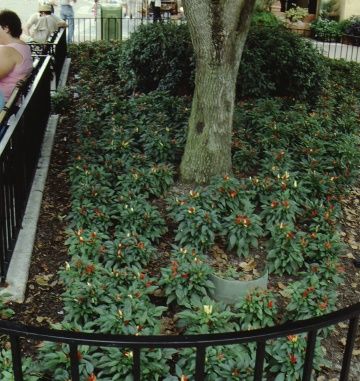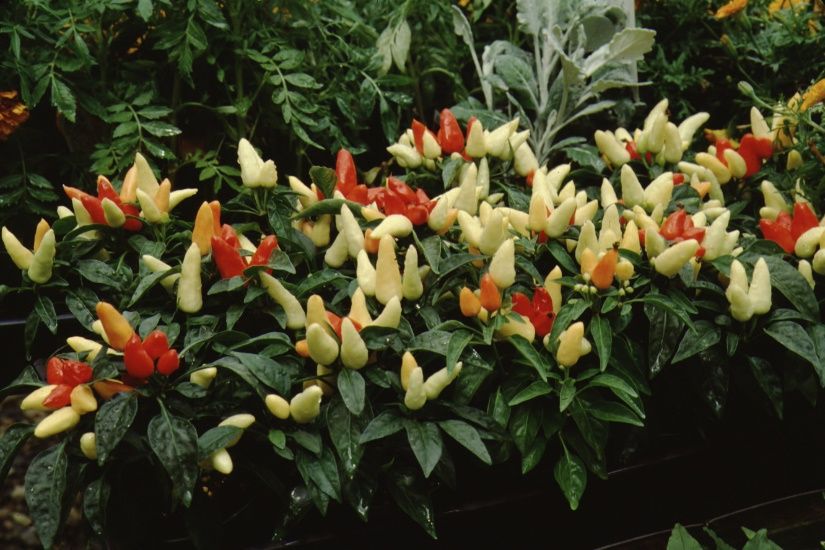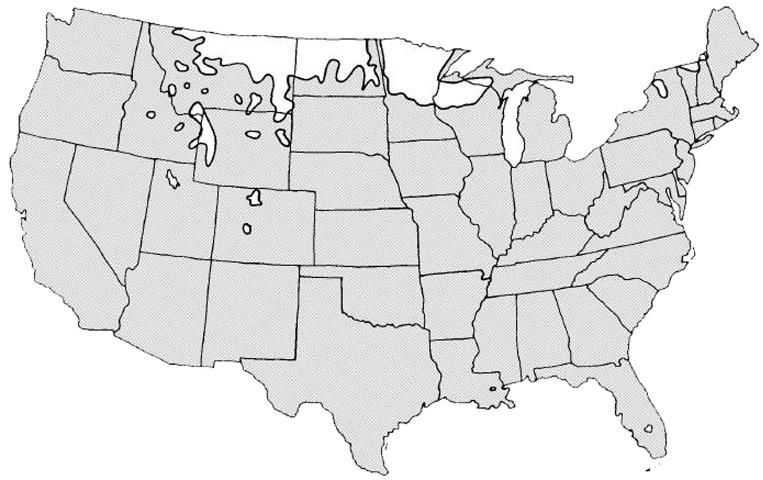Introduction
Ornamental peppers reach 10 to 20 inches in height and are grown as annuals or pot plants, producing colorful fruits from May until frost. In warmer climates, ornamental peppers are perennial and one of the best bedding plants for hot weather conditions, performing beautifully as a ground cover in mixed flower borders, as an edging, or in containers. Even though they can be perennial in USDA hardiness zones 9b, 10, and 11, plants are usually changed out at the end of the season. Fruits are available in a wide range of colors, from red, purple, yellow, orange, or white. Several colors are often seen at the same time on plants as the fruits ripen and change color. While the peppers are said to be edible, most palates will find them much too hot.

Credit: Edward F. Gilman, UF/IFAS

Credit: Edward F. Gilman, UF/IFAS

Credit: Edward F. Gilman, UF/IFAS
General Information
Scientific name: Capsicum annuum
Pronunciation: KAP-sick-um AN-yoo-um
Common name(s): ornamental pepper, bush red pepper
Family: Solanaceae
Plant type: annual
USDA hardiness zones: all zones (Figure 4)
Planting month for zone 7: Jun; Jul
Planting month for zone 8: May; Jun
Planting month for zone 9: Mar; Apr; May; Sep; Oct
Planting month for zone 10 and 11: Feb; Mar; Apr; May; Oct; Nov; Dec
Origin: not native to North America
Invasive potential: not known to be invasive
Uses: container or above-ground planter; mass planting; border
Availability: generally available in many areas within its hardiness range

Credit: undefined
Description
Height: 1 to 1½ feet
Spread: 1 to 1½ feet
Plant habit: round
Plant density: dense
Growth rate: moderate
Texture: medium
Foliage
Leaf arrangement: alternate
Leaf type: simple
Leaf margin: entire
Leaf shape: ovate
Leaf venation: bowed
Leaf type and persistence: not applicable
Leaf blade length: 2 to 4 inches
Leaf color: green
Fall color: not applicable
Fall characteristic: not applicable
Flower
Flower color: white
Flower characteristic: inconspicuous and not showy
Fruit
Fruit shape: elongated
Fruit length: 3 to 6 inches
Fruit cover: fleshy
Fruit color: orange; white; yellow
Fruit characteristic: persists on the plant
Trunk and Branches
Trunk/bark/branches: not applicable
Current year stem/twig color: green
Current year stem/twig thickness: thick
Culture
Light requirement: plant grows in full sun
Soil tolerances: clay; sand; acidic; loam
Soil salt tolerances: unknown
Plant spacing: 6 to 12 inches
Other
Roots: not applicable
Winter interest: not applicable
Outstanding plant: not particularly outstanding
Invasive potential: not known to be invasive
Pest resistance: long-term health usually not affected by pests
Use and Management
Ornamental peppers will grow quite easily in full sun or partial shade and do best in a fairly rich and evenly moist growing medium. They can be planted on 12 to 18 inch centers to form a solid mass of colorful fruits.
Propagation is by seed, which should not be covered with soil.
There are many cultivars for fruit size and color.
Pests and Diseases
No pests or diseases are of major concern except for occasional leaf-chewing insects.